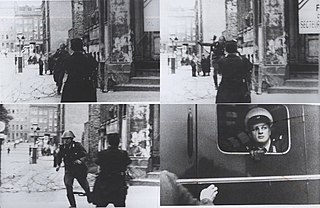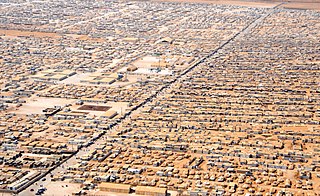The United Nations High Commissioner for Refugees (UNHCR) is a United Nations agency mandated to aid and protect refugees, forcibly displaced communities, and stateless people, and to assist in their voluntary repatriation, local integration or resettlement to a third country. It is headquartered in Geneva, Switzerland, with over 18,879 staff working in 138 countries.

The United Nations Relief and Works Agency for Palestine Refugees in the Near East (UNRWA) is a UN agency that supports the relief and human development of Palestinian refugees. UNRWA's mandate encompasses Palestinians displaced by the 1948 Palestine War and subsequent conflicts, as well as their descendants, including legally adopted children. As of 2019, more than 5.6 million Palestinians are registered with UNRWA as refugees.

A refugee, conventionally speaking, is a person who has lost the protection of their country of origin and who cannot or is unwilling to return there due to well-founded fear of persecution. Such a person may be called an asylum seeker until granted refugee status by the contracting state or the United Nations High Commissioner for Refugees (UNHCR) if they formally make a claim for asylum.
Palestinian refugees are citizens of Mandatory Palestine, and their descendants, who fled or were expelled from their country over the course of the 1947–49 Palestine war and the Six-Day War. Most Palestinian refugees live in or near 68 Palestinian refugee camps across Jordan, Lebanon, Syria, the West Bank and the Gaza Strip. In 2019 more than 5.6 million Palestinian refugees were registered with the United Nations.

Amman New Camp or Al-Wehdat camp, locally known as Al-Wihdat, which is located in the Hay Al Awdah neighbourhood, in southeast Amman, the capital city of Jordan occupies a 0.48 km2 (0.19 sq mi), Of the ten recognized Palestinian refugee camps in Jordan, Al-Wehdat is the second largest, with a population of roughly 57,000 registered refugees, which includes 8,400 students. The United Nation body responsible for administrating Palestinian refugee camps, is the Relief and Works Agency for Palestinian Refugees in the Near East (UNRWA).

An internally displaced person (IDP) is someone who is forced to leave their home but who remains within their country's borders. They are often referred to as refugees, although they do not fall within the legal definitions of a refugee.

A refugee camp is a temporary settlement built to receive refugees and people in refugee-like situations. Refugee camps usually accommodate displaced people who have fled their home country, but camps are also made for internally displaced people. Usually, refugees seek asylum after they have escaped war in their home countries, but some camps also house environmental and economic migrants. Camps with over a hundred thousand people are common, but as of 2012, the average-sized camp housed around 11,400. They are usually built and run by a government, the United Nations, international organizations, or non-governmental organization. Unofficial refugee camps, such as Idomeni in Greece or the Calais jungle in France, are where refugees are largely left without the support of governments or international organizations.

Danish Refugee Council (DRC) is a private Danish humanitarian nonprofit organization, founded in 1956. It serves as an umbrella organization for 33 member organizations.

Yarmouk is a 2.11-square-kilometer (520-acre) district of the city of Damascus, populated by Palestinians. It is located 8 kilometers (5.0 mi) from the center of Damascus and within municipal boundariess; this was not the case when it was established in 1957. It contains hospitals and schools. Yarmouk is an "unofficial" refugee camp, as UNRWA rejected a Syrian government request to recognize the camp in 1960. Now depopulated, it was previously home to the largest Palestinian refugee community in Syria. As of June 2002, there had been 112,550 registered refugees living in Yarmouk.

Palestinians in Iraq are people of Palestinians, most of whom have been residing in Iraq after they were displaced in 1948. Before 2003, there were approximately 34,000 Palestinians thought to be living in Iraq, mainly concentrated in Baghdad. However, since the 2003 Iraq War, the figure lies between 10,000–13,000, although a precise figure has been hard to determine. The situation of Palestinians in Iraq deteriorated after the fall of Saddam Hussein and particularly following the bombing of the Al-Askari Mosque in 2006. Since then, with the rise in insecurity throughout Iraq, they have been the target of expulsion, persecution and violence by Shia militants, and the new Iraqi Government with militant groups targeting them for preferential treatment they received under the Ba'ath Party rule. Currently, several hundred Palestinians from Iraq are living in border camps, after being refused entry to neighbouring Jordan and Syria. Others have been resettled to third countries.
There are multiple humanitarian, medical, economic, and industrial effects of the 2008–2009 Gaza War which started with the Israeli air strikes on 27 December 2008 and ended on 18 January with a cease-fire implemented unilaterally by Israel, and later the same day by Hamas and other Palestinian factions. The cease-fire followed twenty-two days of bombardment by land, sea and air which left over 1,300 Palestinians dead and over 5,000 injured, and the death of 13 Israelis. The United Nations Development Programme warned that there will be long-term consequences of the attacks on Gaza because the livelihoods and assets of tens of thousands of Gaza civilians have been affected.
Refugees of the Syrian Civil War are citizens and permanent residents of Syria who have fled the country throughout the Syrian Civil War. The pre-war population of the Syrian Arab Republic was estimated at 22 million (2017), including permanent residents. Of that number, the United Nations (UN) identified 13.5 million (2016) as displaced persons, requiring humanitarian assistance. Of these, since the start of the Syrian Civil War in 2011 more than six million (2016) were internally displaced, and around five million (2016) had crossed into other countries, seeking asylum or placed in Syrian refugee camps worldwide. It is often described as one of the largest refugee crises in history.

Qatar Charity is a humanitarian and development non-governmental organization in the Middle East. It was founded in 1992 in response to the thousands of children who were made orphans by the Afghanistan war and while orphans still remain a priority cause in the organization's work with more than 150,000 sponsored orphans, it has now expanded its fields of action to include six humanitarian fields and seven development fields.

Syrian refugee camp and shelters are temporary settlements built to receive internally displaced people and refugees of the Syrian Civil War. Of the estimated 7 million persons displaced within Syria, only a small minority live in camps or collective shelters. Similarly, of the 8 million refugees, only about 10 percent live in refugee camps, with the vast majority living in both urban and rural areas of neighboring countries. Beside Syrians, they include Iraqis, Palestinians, Kurds, Yazidis, individuals from Somalia, and a minority of those who fled the Yemeni and Sudanese civil wars.

Present absentees are Arab internally displaced persons (IDPs) who fled or were expelled from their homes in Mandatory Palestine during the 1947–1949 Palestine war but remained within the area that became the state of Israel. The term applies also to the descendants of the original IDPs.

Palestinians in Syria are people of Palestinian origin, most of whom have been residing in Syria after they were displaced from their homeland during the 1948 Palestinian exodus. Palestinians hold most of the same rights as the Syrian population, but cannot become Syrian nationals except in rare cases. In 2011, there were 526,744 registered Palestinian refugees in Syria. Due to harsh conditions, the number of registered refugees has since dropped to about 450,000 due to many Palestinians fleeing to Lebanon, Jordan or elsewhere in the region to escaping to Europe as refugees, especially to Germany and Sweden.
Syrians in Lebanon refers to the Syrian migrant workers and, more recently, to the Syrian refugees who fled to Lebanon during the Syrian Civil War. The relationship between Lebanon and Syria includes Maronite-requested aid during Lebanon's Civil War which led to a 29-year occupation of Lebanon by Syria ending in 2005. Following the outbreak of the Syrian Civil War, refugees began entering Lebanon in 2011. Lebanon's response towards the influx of refugees has been criticized as negative, with the Lebanese government leaving them undocumented and limited and attacks on Syrian refugees by Lebanese citizens which go unaddressed by authorities. Despite the strained relationship between the Syrians and Lebanese, taking into consideration only Syrian refugees, Lebanon has the highest number of refugees per capita in the world, with one refugee per four nationals. The power dynamic and position of Syria and Lebanon changed drastically in such a short amount of time, it is inevitable that sentiments and prejudices prevailed despite progressions and changes in circumstance.
A refugee crisis can refer to difficulties and dangerous situations in the reception of large groups of forcibly displaced persons. These could be either internally displaced, refugees, asylum seekers or any other huge groups of migrants.

The Saudi Fund for Development (SFD) is a Saudi Arabian government agency that provides development assistance to developing countries by financing social and infrastructure projects with the aim of improving lives and communities, which leads to supporting the economies of recipient countries by enhancing growth and job opportunities. SFD was established in 1974 and began operations in 1975. SFD's activities include development, finance, trade and funding. SFD is led by H.E. Mr. Ahmed bin Aqeel Al-khateeb who is the Chairman of the Board of Directors and Minister of Tourism for Saudi Arabia. Dr. Khalid S. Alkhudairy is the Chief Executive Officer (CEO) of SFD.

On 22 September, 2022, a ship carrying migrants escaping Lebanon sank off the coast of Tartus, Syria. The victims, intending to escape the Lebanese liquidity crisis, are estimated to number around 150 people, hailing from Syria, Lebanon, and Palestine. It has been described as one of the deadliest shipwrecks in the eastern Mediterranean in recent years.













